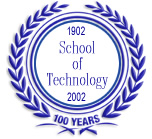|
Technology
in Sport and Exercise Science
M. Thomas Woodall, Ph. D.
Professor Emeritus
Eastern Illinois University
Technological
advances have made a significant impact on most every aspect of our lives
today. Computers and other mechanical and electronic machines/devices
have not only changed many vocations and home environments, but we observe
their beneficial effects in competitive sport as well as in health and
exercise programs. With the exercise physiologist interested in documenting
the immediate and chronic effects of exercise on the human organism, new
evaluation tools and techniques are constantly studied in human performance
and research laboratories around the world. These are but four examples
of how technology is currently being employed to assist those involved
in sport and health/exercise science today.
Body
Fat:
Early investigators employed girths, widths, height/weight ratios
and other anthropometric measurements to help describe one's body
type and degree of fatness. Underwater weighing, though costly and
technically difficult to administer, and skin fold measurements and
numerous prediction equations been valuable in the quest to determine
the percentage of adipose tissue. Most recently, the use of bioelectrical
impedance devices have allowed the measurement of small electrical
currents to be monitored as they pass through the body. Conductivity
is much greater in the fat-free mass and impeded by fat tissue. Thus,
by stepping on a small platform (Figure 1), an objective readout
can be obtained. Though body water is a confounding variable, such
devices can be used in health clubs and other field studies, providing
rather valid (r = .90+) correlations with underwater weighting devices |
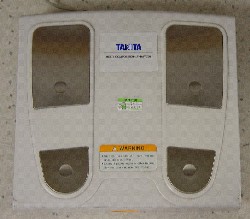 |
| |
Figure
1
|
| |
|
|
Oxygen Consumption:
Time does
not permit a presentation of the cumbersome techniques that were
historically used to measure ones ability to transport and consume
oxygen. Most recently, an extremely light weight unit (Figure
2) has been developed that allows an exerciser to perform vigorous
physical activity, in a field setting, while pulmonary ventilation
and oxygen extraction parameters are determined using flow meters,
internal gas analyzers. and a computer/printer. The device can be
placed in a light-weight back pack allowing O2 costs to be studied
for a wide variety (walking, jogging, weight lifting, biking etc.)
of physical activities.
|
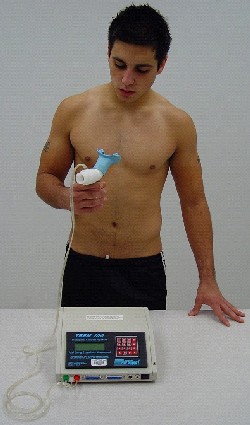 |
| |
Figure
2
|
| |
|
Heart
Rate Monitors:
When coaches and athletes know the heart rate response to any
given exercise intensity, scientifically sound training programs can
be developed and monitored. The heart rate wrist watch, with its chest
strap transmitter is now worn by athletes in any number of sports
(Figure 3) The electrical impulse of each complete cardiac
cycle is transmitted to a receiving unit that then displays not only
the current rate, but is capable of storing many hours worth of information
that can be downloaded and analyzed. |
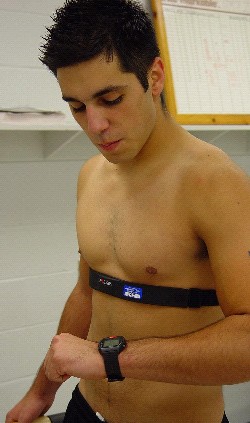 |
| |
Figure
3
|
Electronic
Timing:
In competitive sport, there is an ongoing need to be able to accurately
time performances. No where is the need for precise timing greater,
than in track and field competition. In years gone by, track officials
manually started and stopped hand held spring driven stop watches.
Today, electronic timing devices are found in most major college track
programs as well as in many high schools. The starter's pistol, time
clocks and finish line cameras and computers are coordinated in such
a way as to provide frame by frame visual evidence of not only the
time, but the position of each runner as he/she crosses the finish
line. (Figure 4). Though rather expensive, these timing units
provide for great accuracy and reliability in identifying winners,
times and acknowledging new record setting performances. |
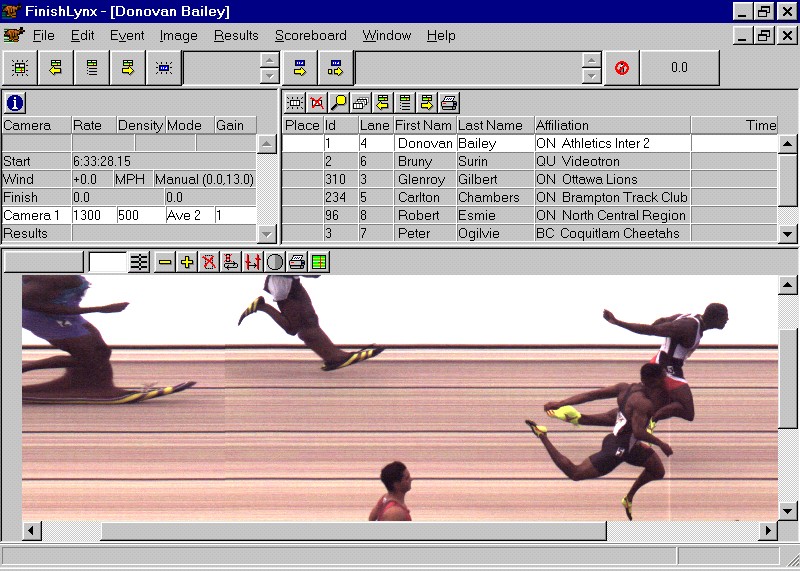 |
|
Figure
4
|
|
